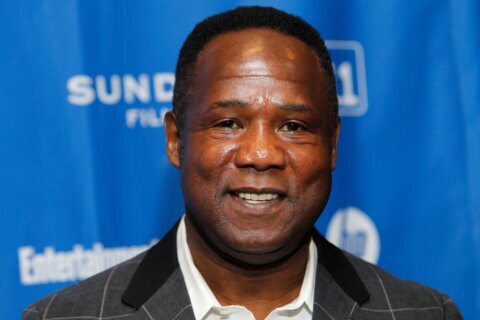WASHINGTON — She made Broadway history as the iconic lead in “A Chorus Line” (1975).
Now, Donna McKechnie stars in “The Pajama Game,” a classic that won the Tony for Best Musical in 1955 and Best Revival in 2006, before hitting Arena Stage now through Dec. 24.
“I’ve always wanted to work here,” McKechnie told WTOP. “It’s such a well-oiled machine and so professional at the same time. They, in a very short time, create a safe space to create.”
Adapted by George Abbott from Richard Bissell’s novel “7 1/2 Cents,” the story unfolds in the fictional Sleep-Tite Pajama Factory, where the handsome new superintendent, Sid Sorokin (Tim Rogan), falls for the head of the union grievance committee, Babe Williams (Britney Coleman), who leads a labor strike seeking a wage increase of seven-and-a-half cents an hour.
Along the way, we hear memorable music and lyrics by the songwriting duo of Richard Adler and Jerry Ross, who famously wrote “Rags to Riches” for Tony Bennett before penning such hit showtunes as “Hey There,” “Steam Heat” and “Hernando’s Hideaway” for “The Pajama Game.”
“Those classic old musicals are two inches off the floor,” McKechnie said. “They’re up there. The energy is high. I have to say how the score is great. The score, the dancing, Parker Esse our choreographer created incredible dances and brought Michael Danziger, who’s a very well-known dance arranger. [He] created all new dance arrangements and Parker opened up my number, which was [originally] just a little soft shoe, to make it more of a song and dance.”
McKechnie plays secretary Mabel across Ed Gero’s strict factory chief Myron “Old Man” Hasler, marking a fascinating time capsule of workplace romance in our current context of #MeToo.
“I’m the office wife and it’s about relationships in the workplace,” McKechnie said. “Now, there’s this new thing that’s shifting our culture about sex in the workplace and how far do you go where it’s inappropriate and what are the boundaries? People are unsure about this at this time. When I grew up in show business in New York in the late ’50s, it was something that you had to just expect was going to happen. There was no recourse, so this is very different.”
As a result, the show keeps the same dialogue but alters the delivery of certain segments.
“We stay true to the original script, which was sexist like a Doris Day movie. … Sometimes people gasp,” McKechnie said. “The ‘Hey There’ reprise [originally] ended with her getting upset and can’t finish the song. The choice was made by our director Alan Paul to complete the song, be strong [and] persevere. It makes it more palatable, but we never change the dialogue [because] it’s a slice of our history. It’s important to have that reflection. I was there!”
Born in Pontiac, Michigan in 1942, McKechnie grew up in the Detroit suburbs surrounded by factories similar to “The Pajama Game,” before falling for musicals by going to the movies.
“I knew about New York when I was very young because of Cyd Charisse, Fred Astaire and Ginger Rogers, then ‘The Red Shoes’ literally changed my life,” McKechnie said. “My mother was my champion and I was really lucky there were two great teachers in the Detroit area [and] I had this great ballet training. Whenever I talk to young dancers I say, ‘Whatever you do, just keep doing your ballet. That is going to take you wherever you need to go style-wise.”
At age 17, she ran away from home and moved to New York City to become a dancer.
“My parents were hoping I would come home, so they didn’t support me or send me money,” McKechnie said. “It fueled my passion to keep working and show them I could do it. I got a job [in the] ballet corps at Radio City. For five days I did it, then I got ‘West Side Story’ [and left]. I was so young and naive that I didn’t know you had to give notice! They thought I was hit by a truck. The costume was already made, we’d done our dress rehearsal, it was embarrassing.”
After touring in “West Side Story” and auditioning for countless other shows, she finally landed her Broadway debut in Frank Loesser’s “How to Succeed in Business Without Even Trying” (1961). It was here that she met choreographer Bob Fosse and his wife Gwen Verdon, who gave each member of the “nameless” ensemble a chance to bring something to the role.
“Bob Fosse gave us an assignment: ‘I want you each to write a summary of your character [and] every time you enter, you’re coming from some place, know why you’re coming there,'” McKechnie said. “It just touched our imagination and we could go on from there. He picked people who were individuals, all sizes and shapes, as with all his shows. Gwen was our dance captain. We were intimidated! There’s Gwen Verdon going, ‘Could you move over a little?'”
She was equally intimidated by Ethel Merman during Irving Berlin’s “Call Me Madam.”
“I would’ve done anything to please her; I admired her,” McKechnie said. “We were in St. Louis at the Muny Opera. It’s so hot and I’m sweating. … Ethel Merman sent a message back with a stage manager and I said, ‘Oh! I’m happy to do whatever she suggests,’ and he just said, ‘She says to stop perspiring so much because it bothers her concentration.’ … I was stumped.”
Television roles followed, including soap opera “Dark Shadows” (1966) — “They had to kill me off with Styrofoam rocks; one of my better memories” — and the variety show “Hullabaloo” (1965), which introduced her to her future husband and choreographer Michael Bennett.
“He was terrific and a great dancer,” McKechnie said. “I said, ‘What do you want to do when you grow up? Because you can’t keep dancing your whole life.’ … He looked at me so sincerely and said, ‘I’m going to be a choreographer,’ but he said it like he had already arrived there. It was already set. There was destiny there and I just went, ‘Ooh, well, don’t forget about me!'”
Sure enough, Bennett didn’t forget about her when it came time for him to choreograph “Promises, Promises” (1968), based on Billy Wilder’s romantic comedy “The Apartment” (1960) with the dream team of Burt Bacharach (music), Hal David (lyrics) and Neil Simon (book).
“Michael said, ‘She’s a dancer. Let me put her in the dance number,’ because he had this great number at the end of the first act and it was just fantastic,” McKechnie said. “So, he saved my job and it put me on the map. Then we did ‘Company’ (1970), a really groundbreaking [Stephen] Sondheim musical [which was] a very unique and history-making experience.”
It was around this time that the seeds of “A Chorus Line” were planted during workshops.
“At first it was going to be a backstage murder mystery, then it was going to be on one set with dancers coming in without talking, so it morphed into all these different things,” she said. “We finally got [producer] Joe Papp to give Michael the theater carte blanche. … He had heard recordings of us all sitting around talking about our childhood, why we’re dancers and where we’re from: three simple questions that actually begin ‘A Chorus Line.’ That’s how it started.”
The result was a captivating backstage premise, following a group of dancing hopefuls as they audition in front of a demanding director for an upcoming Broadway musical. McKechnie’s character Cassie ultimately gets the part, but the outcome wasn’t always going to be that way.
“[Michael] was trying to be in a world after Watergate [and] trying to be realistic, knowing that if he was the director he would not let her in that show,” McKechnie said. “But Marsha Mason, who was a wonderful actress and a friend of Michael’s, came and watched the throughline of Cassie and was very helpful. She said, ‘She has to get the job! … If she doesn’t, everybody loses. He loses and never advanced in his resolve, and she’s never given a second chance.'”
Turns out, it was the right call, touching a nerve with audiences that weren’t even in showbiz.
“The second chance theme rang true for so many people; I was surprised,” McKechnie said. “Oh my god, the letters I got from businessmen who lost their jobs at that time and had to start over again [or] football players talking about their lives on the lines of the football field. … You hope it gets out. You don’t know how people are going to take it. It’s bigger than us.”
Even before “A Chorus Line” hit Broadway, it was drawing big audiences Off-Broadway.
“We had this roaring success in this little theater, the Newman Theatre downtown, and people were flying in from the coasts,” McKechnie said. “You’d have George Burns and Diana Ross sitting on a step because there weren’t enough chairs in the theater. Groucho Marx came like 20 times! He gave us a big cake with a foot with an ax in it like ‘break a leg.’ It was hilarious.”
By the time it hit Broadway, it was already a phenomenon, becoming the longest-running show in history (1975-1990). While that record has since been broken — the current leader is now “The Phantom of the Opera” (1988-present) — the music of Marvin Hamlisch lives on.
“He was a great guy, a really bighearted fellow, funny, a great composer and just a great entertainer,” McKechnie said. “I do symphonies now of his work [and] people just love his work. He was a workaholic. He never stopped. He just loved it. There are some people that have the energy of about four people; they’re just born that way; Marvin was one of them.”
As for McKechnie, she’ll always have the title of Tony winner, bagging Best Actress as Cassie.
“That was shocking,” McKechnie said. “My father died just a few weeks before. My mother was in the balcony. … My brain went, ‘OK, now you’re going to walk down the aisle and not fall, now walk up these stairs.’ There was this guide in me walking myself through it. I don’t know how I did it. My voice didn’t sound like mine; I did it without breathing! In the wings, I ran into Richard Burton. Those beautiful blue eyes said, ‘You deserved it.’ I lived on that for five years!’
Still, no matter the accolades, she remains all about the work — as it should be.
“It’s a great honor, but it’s not about that,” McKechnie said. “I’m not being coy, but I didn’t come to New York to win prizes. That’s a fan mentality. No, it’s not about stickers or getting a star on your forehead. It’s about the work. Anyone I know who’s had longevity will say that.”
After such longevity, the 75-year-old McKechnie has two favorite roles over her career.
“I think my favorite was Sally in ‘Follies’ at The Papermill Playhouse,” McKechnie said. “Stephen [Sondheim] and James Goldman were still working together. [That] never happens: 20 years after the original show, the writers come back and rework a piece like this! .. [I was also] at National Theatre in ‘Sweet Charity’ with Bob Fosse. … That was the night he left the planet.”
Click here for more on “The Pajama Game.” Listen to our full chat with Donna McKechnie below:








